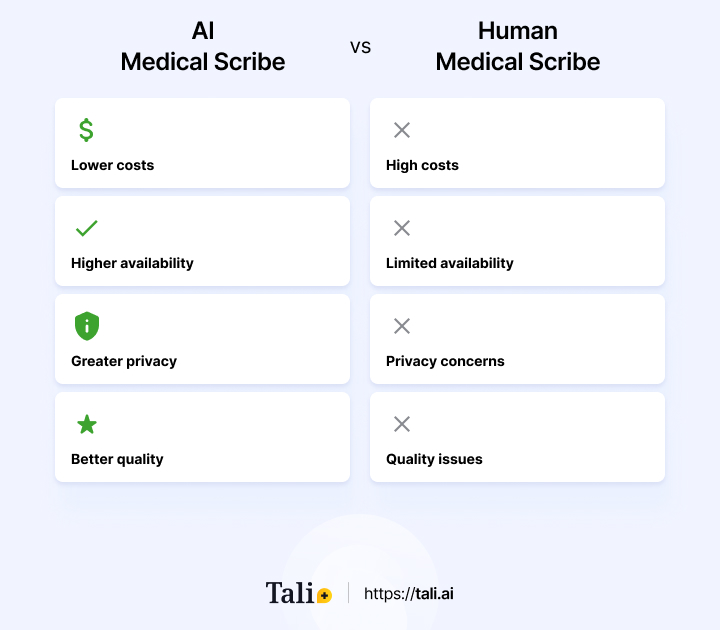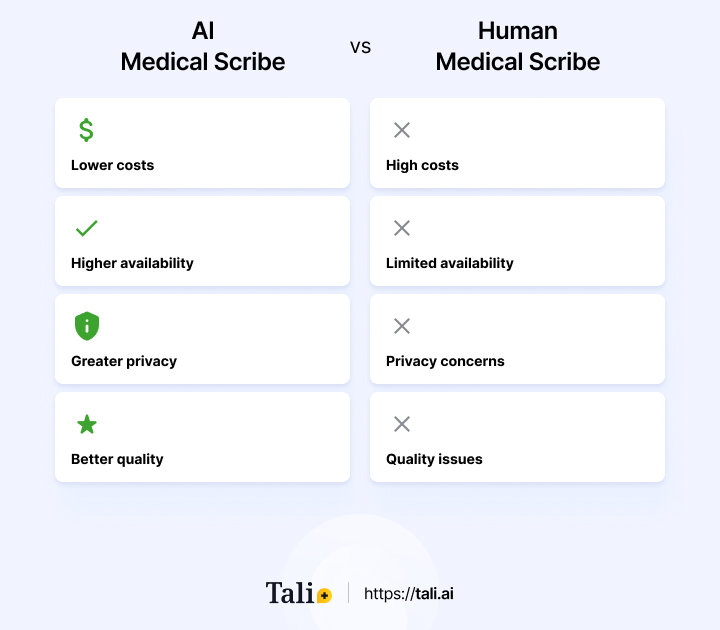The Benefits of AI Medical Scribes in Healthcare Organizations
Table of Contents
Artificial intelligence (AI) is transforming various aspects of healthcare, from diagnosis to treatment to management. One of the most promising applications of AI in healthcare is the use of AI medical scribes, software programs that can automatically document patient encounters and generate clinical notes. This blog post will explore what an AI medical scribe is, how it can benefit patients, physicians, and healthcare organizations, and how to implement one in your healthcare organization.
What is an AI Medical Scribe?
An AI medical scribe is a software program that uses speech recognition and natural language processing (NLP) to capture and transcribe the conversation between a physician and a patient during a clinical encounter. It can also extract relevant information from the conversation, such as symptoms, diagnoses, medications, procedures, and orders, and then populate them into the electronic health record (EHR) system. AI medical scribes can also generate summaries and recommendations based on clinical notes and evidence-based guidelines.
An AI medical scribe aims to automate and streamline the documentation process for physicians, which is often tedious, time-consuming, and error-prone. By using AI medical scribes, physicians can focus more on the patient and less on the computer, improving the quality and efficiency of patient care. AI medical scribes can also reduce physicians' administrative burden and cognitive load, improving their well-being and productivity.
AI Medical Scribe vs. Human Medical Scribe: Pros and Cons

Some healthcare organizations use human medical scribes to assist physicians with documentation. Human medical scribes are trained professionals who accompany physicians during patient visits and manually enter the information into the EHR system. Human medical scribes can offer some benefits, such as reducing physician documentation time and improving patient satisfaction. However, human medical scribes also have some drawbacks, such as:
High costs: Human medical scribes are expensive to hire, train, and manage. According to a study by Health Affairs, the average annual cost of a human medical scribe is $46,000 per physician.
Limited availability: Human medical scribes are scarce and in high demand. There may need to be more human medical scribes to meet the needs of all physicians or patients.
Privacy concerns: Human medical scribes may compromise patient privacy or confidentiality by listening to sensitive or personal information during the encounter.
Quality issues: Human medical scribes may make mistakes or omissions in documentation due to human error or lack of knowledge.
AI medical scribes can overcome these drawbacks and offer more advantages than human medical scribes. AI medical scribe can:
Lower costs: AI medical scribe is more affordable than a human medical scribe. It does not require hiring, training, or managing human staff. It also does not charge per hour or visit but per note or month.
Higher availability: AI medical scribe is always available and accessible. It is independent of the availability and schedule of human staff. It can also work with any physician or patient, regardless of specialty or location.
Greater privacy: AI Medical Scribe technology meets the same privacy requirements as EHRs, safeguarding patient privacy. It does listen and record conversations between physicians and patients but solely focuses on transcribing and analyzing pertinent information for documentation purposes. Humans are not involved in the process and data can be protected using the same standards and technologies as other clinical software.
Better quality: AI medical scribe is more accurate and consistent than a human medical scribe. It does not make mistakes or omissions in documentation due to human error or lack of knowledge. It also consistently follows the best practices and standards for documentation.
How an AI Medical Scribe Can Enhance Patient Care
AI medical scribes can enhance the quality and efficiency of patient care in several ways. First, it can improve the accuracy and completeness of clinical documentation, which is essential for patient safety, quality improvement, billing, and compliance. By using AI medical scribes, physicians can avoid missing or misreporting important information that can affect patient outcomes or lead to legal issues.
Second, it can improve the communication and rapport between physicians and patients. By using AI medical scribes, physicians can maintain eye contact and engage more with the patient, rather than typing or clicking on the computer. This can improve patient satisfaction, trust, and adherence to treatment plans.
AI medical scribes can also provide real-time feedback and suggestions to physicians during the encounter, such as prompting them to ask relevant questions or order appropriate tests.
Third, it can improve the coordination and continuity of care across different providers and settings. By using AI medical scribes, physicians can easily share and access comprehensive and up-to-date clinical notes with other providers involved in the patient's care. This can reduce duplication of work, prevent errors or gaps in care, and facilitate transitions of care.
Practical AI Medical Scribe Solutions for Critical Healthcare Settings

Healthcare organizations can leverage the potential of AI medical scribes to enhance their practice and achieve notable advantages. Here are some examples:
Emergency Departments: Emergency departments are fast-paced and high-stress environments where accurate and timely documentation is crucial for patient safety and quality of care. By using AI medical scribes, emergency physicians can reduce their documentation time, reduce their after-hours documentation, reduce their burnout, increase their happiness, increase their patient throughput, and increase their coding accuracy.
Primary Care: Primary care is the foundation of healthcare delivery, providing comprehensive and continuous care to patients across their lifespan. By using AI medical scribes, primary care physicians can improve their documentation accuracy, consistency and completeness, improve their workflow efficiency, improve their work-life balance, improve their patient communication, and improve their patient satisfaction.
Oncology: Oncology, a specialized field of medicine, offers complex and personalized care to cancer patients. By using AI medical scribes, oncologists can save time on documentation, reduce errors, enhance decision support, improve quality measures, increase referrals, and increase revenue.
Radiology: Radiology is a critical field of medicine where diagnostic imaging is used to detect and treat various diseases and conditions. Using AI medical scribes, radiologists can speed up reporting time, reduce transcription costs, improve report quality, enhance communication with referring physicians, and increase compliance with billing codes.
Behavioral Health: Behavioral health is an essential field of medicine where mental health and substance use disorders are treated. By using AI medical scribes, behavioral health providers can save time on documentation, improve patient engagement, increase access to care, improve care coordination, and increase reimbursement rates thus and increase their revenue.
How to Implement an AI Medical Scribe
Implementing AI medical scribe in your healthcare organization may seem daunting, but it doesn't have to be. Here are some steps you can take to adopt and integrate AI medical scribe in your practice successfully:
Evaluate your current documentation workflow and identify your pain points and goals.
Research different AI medical scribe solutions and compare their features, benefits, and costs.
Choose an AI medical scribe solution that meets your needs and budget.
Test the solution in a pilot project with a small group of physicians and patients.
Collect feedback from the pilot participants and measure the solution's impact on your documentation quality, efficiency, and satisfaction.
Adjust your workflow and settings to optimize your use of the solution.
Scale up your implementation to include more physicians and patients.
Monitor your performance and outcomes and continue to improve your process.
Conclusion
An AI medical scribe is a software program that automatically documents patient encounters and generates clinical notes. It can benefit patients, physicians, and healthcare organizations by improving documentation, communication, and care coordination. AI medical scribes can reduce documentation time, effort, stress, and costs and increase physician joy, satisfaction, productivity, and revenue. AI medical scribes can be successfully implemented in various healthcare settings, such as emergency departments, primary care, oncology, radiology, and behavioral health.
Tali is one of the best AI medical scribe solutions available today. It is easy to use, affordable, and secure. It integrates seamlessly with your EHR system and supports various specialties and settings. You will get access to all the features and benefits of Tali for 14 days with no obligation or commitment.
Take advantage of this opportunity to transform your clinic and boost your performance with Tali. Try it now.
FAQ
An AI medical scribe refers to a software program that employs speech recognition and natural language processing (NLP) to capture, transcribe, and extract relevant information from conversations between physicians and patients during clinical encounters. The information is then populated into the electronic health record (EHR) system, generating clinical notes, summaries, and recommendations based on evidence-based guidelines. The purpose of an AI medical scribe is to streamline and automate the often time-consuming and error-prone process of physician documentation. This allows physicians to focus more on patient care, thereby enhancing patient experiences, reducing physician burnout, and increasing overall healthcare organization efficiency. Furthermore, AI medical scribes have the potential to reduce administrative burden and cognitive load on physicians, positively impacting their well-being and productivity.
AI medical scribes offer several advantages over human medical scribes. While human medical scribes can reduce physician documentation time and improve patient satisfaction, they are associated with high costs, limited availability, privacy concerns, and potential quality issues. On the other hand, AI medical scribes present solutions to these drawbacks. They are more cost-effective due to the elimination of hiring, training, and managing human staff. Their availability is not restricted by scheduling constraints, ensuring constant accessibility. AI medical scribes address privacy concerns by focusing solely on transcribing and analyzing pertinent information, adhering to privacy requirements similar to EHRs. In terms of quality, AI medical scribes are consistent, accurate, and free from human errors or omissions. These advantages position AI medical scribes as a preferable alternative, offering lower costs, broader availability, enhanced privacy, and improved quality compared to their human counterparts.
AI medical scribes contribute to the improvement of patient care in multiple ways. Firstly, they enhance the accuracy and completeness of clinical documentation, which is crucial for patient safety, billing accuracy, compliance, and overall quality improvement. Secondly, AI medical scribes enable better physician-patient communication by allowing physicians to engage directly with patients instead of being engrossed in typing or computer interactions. This, in turn, enhances patient satisfaction, trust, and adherence to treatment plans. Moreover, AI medical scribes offer real-time suggestions and feedback to physicians during patient encounters, ensuring relevant questions are asked and appropriate tests are ordered. Lastly, AI medical scribes improve care coordination and continuity by facilitating the sharing of comprehensive, up-to-date clinical notes among different providers and settings. This reduces duplication of work, prevents gaps in care, and streamlines transitions of care, ultimately leading to higher quality patient care across the healthcare continuum.
Documentation and Administrative Tasks?